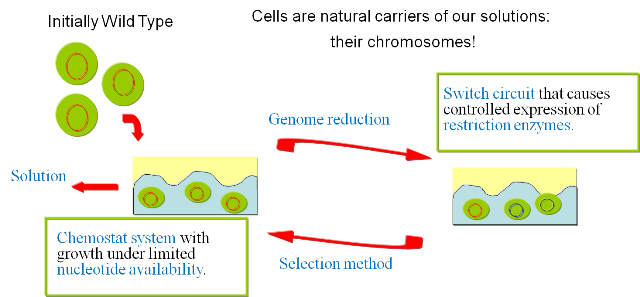Team:ETH Zurich/Project/Overview
From 2008.igem.org
|
Overview: The Minimal Genome ProjectThe reduction of a genome to its most fundamental parts is a task of broad biological interest which has been achieved yet. It addresses the question of which set of genes is absolutely necessary to support life in its most primitive form. Several approaches have been taken by a number of scientists to tackle this problem. Recently, a cleaned-up version of E. coli containing a 15% smaller genome has been presented by Posfai et al. In this approach, however, targeted deletion of genes was applied. This requires an informed, rational step-by-step approach. Therefore, it cannot apply one of the features of biology which allow to explore a much wider space with frequently unexpected outcomes: evolution. Our approach of creating an E. coli showing a minimal genome is largely free of any bias imprinted by our current understanding of E. coli physiology (except, of course, for the applied selection criteria). Genome reduction is achieved by short pulses of two in vivo synthesized enzymes, a restriction enzyme and a ligase. The restriction enzyme randomly cuts the genomic DNA. If two cuts or more are generated within one pulse, a chromosomal fragment might be excluded before the ligase performs its job of religation. This results in the random deletion of chromosomal fragments. Though the chance of this event to happen is rather low considering a single cell, it becomes likely when looking at an entire population. However, this creates the need of having to select for cells which have successfully eliminated parts of their genome. Since manual selection is obviously impossible considering the tremendous number of cells in a culture, it would be convenient to equip cells carrying a small genome with some kind of growth advantage enabling them to outgrow the rest of the population in a continuous culture.
Therefore, we opted for putting a constraint on nucleotide synthesis to make DNA replication the rate-limiting step of proliferation. In this case, cells with a smaller genome should replicate and therewith divide faster than cells carrying larger genomes. Finally, after the last pulse has been applied, the E. coli carrying a dramatically reduced genome will take the lead in our culture.If the nucleotide availability constraint turns indeed out to be a powerful selection mechanism, this method might take us a long way to obtaining a rather unbiased reduced genome |
 "
"
